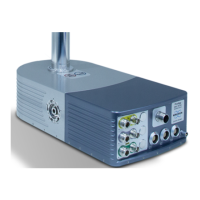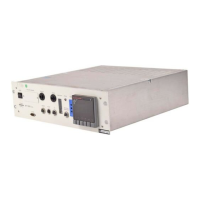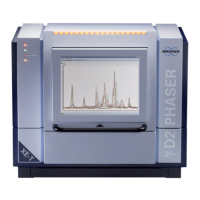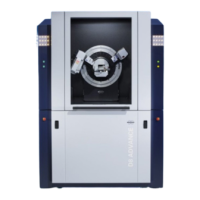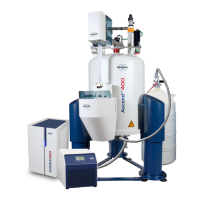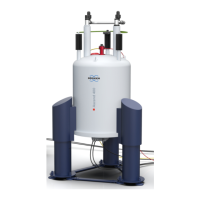24 (107) BRUKER CryoProbe User Manual
System description
Electricity
AC 400 V, 50 Hz, 3 phase
3.6 kW, 8 A average, 51 A peak
Air temperature for outdoor radiator -10 to +40°C
Acoustic noise of outdoor radiator 10 m distant 41 dB(A)
Principle of operation 3.5
0
Gifford-McMahon cycle refrigerator 3.5.1
In Figure 3.6.
, a Gifford-McMahon cycle refrigerator is shown schematically. It
consists of a closed cylinder and a displacer that covers about three quarters of
the cylinder volume. The displacer is moved up and down, thus the two spaces
above and below the displacer are varied from zero to maximum but the total vol-
ume remains constant. A seal on the displacer prevents leakage from one volume
to the other.
The two spaces are connected through a regenerative heat-exchanger and linked
to a gas supply. The gas supply consists of inlet and outlet valves, a gas compres-
sor, and high and low pressure reservoirs. Its valves are synchronized with the
position of the displacer. A heat exchanger downstream of the gas compressor
cools the gas to ambient temperature before it enters the Gifford-McMahon cycle
refrigerator.
The pressure above and below the displacer is always the same except for small
pressure drops across the regenerator when gas is flowing through it. Virtually no
work is required to move the displacer in the cylinder. No work is done on the gas
and the gas does no work on the displacer. Pressure in the system is increased or
decreased only by operation of the inlet or outlet valves.
Inside the regenerator, finely divided metallic material pre-cools the gas when
passing downwards to the cold space and heats the gas when returning from the
cold space.
The refrigerator operates as follows:
1. Pressure buildup
With the displacer at the bottom of the cylinder and the outlet valve closed, the
inlet valve is opened and the pressure in the system increases. High pressure
gas enters through the inlet valve to fill the regenerator and the space above
the displacer, volume 1.
2. Intake stroke
With the inlet valve still open, the displacer is moved from the bottom of the
cylinder to the top. This displaces high pressure gas from the space above the
displacer, volume 1, through the regenerator to the space below the displacer,
volume 2. In passing through the regenerator, the gas cools down and con-
tracts. Additional gas enters the system to maintain the maximum cycle pres-
sure.
3. Pressure release and expansion
With the displacer at the top of the cylinder, the inlet valve closes and the out-
let valve opens to the low pressure reservoir. Gas escapes and the pressure
decreases, causing a drop in the gas temperature. The temperature decrease
